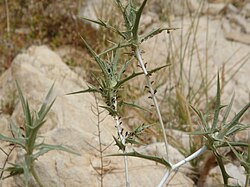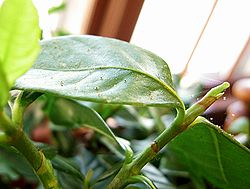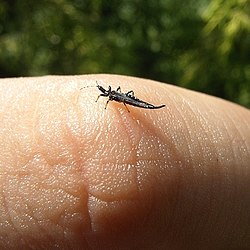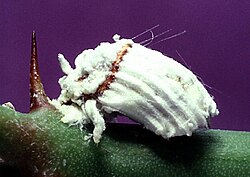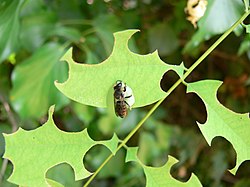Difference between revisions of "AY Honors/Flower Culture/Answer Key"
| Line 29: | Line 29: | ||
[[Image:Ponticulothrips diospyrosi.jpg|right|thumb|250px|'''Thrips''' ''Thysanoptera sp.'']] | [[Image:Ponticulothrips diospyrosi.jpg|right|thumb|250px|'''Thrips''' ''Thysanoptera sp.'']] | ||
[[Image:Icerya-purchasi.jpg|right|thumb|250px|'''Cottony cushion scale''' ''Icerya purchasi'']] | [[Image:Icerya-purchasi.jpg|right|thumb|250px|'''Cottony cushion scale''' ''Icerya purchasi'']] | ||
| − | [[Image: | + | [[Image:Megachile rotundata.JPG|right|thumb|250px|Leaf damage caused by '''Leaf cutting bee''' ''Megachile'' sp.]] |
| − | |||
| − | |||
===Aphids=== | ===Aphids=== | ||
Likely to be found on new shoots and buds, aphids are soft bodied insects 1-2mm long. Often green but occasionally light-brown, and sometimes with wings, they may cover (in a colony) the complete growing tip of the plant. Aphids are most active in spring and summer and multiply at a prodigious rate feeding on the sap of the plant by piercing the plant cells via a proboscis. In large quantities they may seriously retard the growth of the plant and ruin buds. They are particularly damaging to the new shoots with subsequent damage to the emerging leaves which become malformed with much the same appearance as leaf-curl in peaches. | Likely to be found on new shoots and buds, aphids are soft bodied insects 1-2mm long. Often green but occasionally light-brown, and sometimes with wings, they may cover (in a colony) the complete growing tip of the plant. Aphids are most active in spring and summer and multiply at a prodigious rate feeding on the sap of the plant by piercing the plant cells via a proboscis. In large quantities they may seriously retard the growth of the plant and ruin buds. They are particularly damaging to the new shoots with subsequent damage to the emerging leaves which become malformed with much the same appearance as leaf-curl in peaches. | ||
| Line 53: | Line 51: | ||
===Leaf cutting bee=== | ===Leaf cutting bee=== | ||
Leafcutter bees are 6-16mm long and mostly black with bands of light-colored hair. They chew pieces from the edges of leaves. The pieces are regular in shape, circular or oval. Damage is not often significant. | Leafcutter bees are 6-16mm long and mostly black with bands of light-colored hair. They chew pieces from the edges of leaves. The pieces are regular in shape, circular or oval. Damage is not often significant. | ||
| + | <br style="clear:both"> | ||
==5. Give instructions for making a window box and tell its use.== | ==5. Give instructions for making a window box and tell its use.== | ||
Revision as of 01:56, 7 November 2007
1. Define each of the following:
a. Perennials
A perennial is a plant that lives for more than two years. Perennial plants are divided into two large groups, those that are woody and those that are herbaceous. All woody plants are perennials since they form woody tissue that persists from one year to the next. Woody perennials develop a woody base or root system from which the foliage and flower stems grow year after year while the plant is alive. In common usage the term perennial generally describes herbaceous perennials.
b. Annuals
Annuals die each year. Depending on your climate annuals may be for summer planting (in snow regions) or winter planting (in low deserts). These plants produce many flowers and seeds in their life cycle to help perpetuate them. As a result many annuals seem to grow back each year when it is more likely a new plant from a seed has grown in its place.
c. Biennials
Biennials are plants that live for two years. They generally take on different forms in each of these years, producing seeds only in the second year.
2. Give general instructions for making a hotbed. What is the difference between a hotbed and a cold frame?
Adventist Youth Honors Answer Book/Hotbed cold frame
3. What is drainage? Of what importance is it?
Drainage is the natural or artificial removal of surface and sub-surface water from a given area. Many agricultural soils need drainage to improve production or to manage water supplies.
In moist climates, soils may be adequate for cropping with the exception that they become waterlogged for brief periods each year, from snow melt or from heavy rains. Soils that are predominantly clay will pass water very slowly downward, meanwhile plant roots suffocate because the excessive water around the roots eliminates air movement through the soil. Other soils may have an impervious layer of mineralized soil, called a hardpan or relatively impervious rock layers may underlie shallow soils. Drainage is especially important in tree fruit production. Soils that are otherwise excellent may be waterlogged for a week of the year, which is sufficient to kill fruit trees and cost the productivity of the land until replacements can be established. In each of these cases appropriate drainage is used to carry off temporary flushes of water to prevent damage to annual or perennial crops.
In farming drier areas, irrigation is often used, and one would not consider drainage necessary. However, irrigation water always contains minerals and salts, and these can be concentrated to toxic levels by evapotranspiration. Irrigated land may need periodic flushes with excessive irrigation water and drainage to remove these toxic minerals.
4. Name three plant pests and tell how to control them.
Roses Rosa sp. are susceptible to a number of pests, diseases and disorders. A large number of the problems affecting roses are seasonal and climatic.&
Aphids
Likely to be found on new shoots and buds, aphids are soft bodied insects 1-2mm long. Often green but occasionally light-brown, and sometimes with wings, they may cover (in a colony) the complete growing tip of the plant. Aphids are most active in spring and summer and multiply at a prodigious rate feeding on the sap of the plant by piercing the plant cells via a proboscis. In large quantities they may seriously retard the growth of the plant and ruin buds. They are particularly damaging to the new shoots with subsequent damage to the emerging leaves which become malformed with much the same appearance as leaf-curl in peaches.
Two-spotted mite
Previously known as red-spider mite these arachnids prefer the underside of leaves and are difficult to see with an unaided eye. Evidence of their presence is silvering of leaves where the mites have destroyed individual leaf cells. Fine webbing and eggs on the undersides of leaves is further evidence of the presence of Tetranychus urticae.
Thrips
Thrips are slim-winged insects 1mm in length, resembling fine black slivers of wood. Preferring light-coloured blooms and often appearing in plague numbers flowers are often left looking bruised and lustreless.
Caterpillars
The tortryx moth Lozotaenia forsterana is a prominent pest of roses, although not the sole pest. The caterpillars are green, up to 15mm long, and can be found boring into buds or within curled leaves. When disturbed the caterpillars move swiftly, dropping to the ground on a fine thread. Damage is chewn leaves and flowers and buds with "shot holes".
Scale insects
Cottony cushion scale
This scale infests twigs and branches. The mature female is oval in shape, reddish-brown with black hairs, 5 mm long. When mature the insect remains stationary and produces an egg sac in grooves, by extrusion, in the body which encases hundreds of red eggs. The insect causes little damage but produces copious honeydew that can cause damaging sooty mold.
California red scale
A hard scale, orange to orange-pink, the female covering being less than 1.5mm across. Often in plague numbers this scale infests upper surfaces of foliage causing yellowing, leaf fall, and twig and branch dieback. Serious infestations can cause plant death.
Rose scale
Mainly found on the stems and branches of the plant, lack of control will allow the pest to spread to flower stalks and petioles. At this point the plant would be stunted, spindly and with a white, flaky crust of scales on the bark. Female Aulacaspis rosae may live for 1 year and may lay 80 eggs each with several overlapping generations living within milliimetres of the original parent.
Leaf cutting bee
Leafcutter bees are 6-16mm long and mostly black with bands of light-colored hair. They chew pieces from the edges of leaves. The pieces are regular in shape, circular or oval. Damage is not often significant.
5. Give instructions for making a window box and tell its use.
6. Prepare the soil, fertilize, plant, and grow to maturity three different kinds of annuals.
7. Care for two or more perennial flowers growing outdoors for one season by fertilizing, watering, weeding, and treating for pests as needed. Maintain a written record with weekly entries, listing work done.
8. Which three plant nutrients are most important to flowering plants?
9. Identify three flowering plants adapted to each of the following conditions:
a. Shade
b. Dry soil
c. Full sun
d. Moist soil
10. What is the purpose of a soil test?
The purpose of a soil test is to determine the nutrient content of the soil. This will allow the gardener to select plants that will grow best in the existing soil conditions or to determine what nutrient supplements are required to amend the soil for the intended plants.
11. Make a picture collection of ten annuals, five perennials, and two biennials. Label and know the name of each from memory.
Annuals
Biennials
Perennials
References
- Wikipedia articles:
- ↑ Ross, D.,Rose-growing for Pleasure, Lothian Publishing, Melbourne, 1985, ISBN 0 85091 181 8 pp. 27
